We recently received a Green Light Trigger unit which is basically two powerful magnets that attach to the underside of your motorcycle and promise to trigger a green light.
Read on and find out if the Green Light Trigger actually works!
Why lights won’t change
We contacted several state transport departments for their technical advice.
They say these lights are controlled by a induction loop (typically < 0.5 volt ac and < 5 mA) cut into the pavement.
It creates an electro-magnetic field to detect ferromagnetic metals such as iron, cobalt, nickel, steel and manganese.
Some people erroneously believe these rectangles are actually scales that detract the weight of vehicles and therefore don’t pick up light motorcycles!
For the best possible detection of the metal in your motorcycle, you should position your bike longitudinally right above one of the cut lines or the lead-in cable lines (on the left in the photo below).

If there are two rectangles cut into the pavement, line up over the centre line for the best effect.
Be aware of oil and diesel spills in the centre of the lane, particularly in the wet. If you pull up on the left or right cut line, be careful of putting your foot down in the slippery centre as you may loose your footing, drop the bike and maybe fall under a vehicle in a side lane.
But here’s the most important part: Don’t move away or continue past the loop! Stay over those lines for the loop to detect your bike.
Also, be aware that lining up over a side cut line or lead-in cable next to a running lane exposes you to the danger of being rear-ended by an errant driver straying out of their lane.
It has also been suggested that if you deploy your side stand directly over a cut line it will help trigger the lights.
We tried it and it doesn’t seem to work, but it may depend on the metal composition of your sidestand. Some modern motorcycles have non-ferromagnetic alloy sidestands to save weight.
Sensitive issue
The transport departments tell us the the sensitivity of the loops is set to detect all vehicles.
However, sensitivity is a delicate balancing act: too low and it won’t pick up a motorcycle or bicycle; too high and it will pick up false readings for cars in adjacent lanes.
If you believe the sensitivity is set too low at a set of lights, you can contact the relevant department in your state or local council area and ask for it to be increased.
Green Light Trigger
But what about this $US30 Green Light Trigger which is basically two powerful neodymium or rare-earth magnets?
The science suggests they could work because the induction loop creates a magnetic effect which should detect other magnets: either attracting or repelling.
I tried it out on my Triumph Street Scrambler and a Kawasaki Versys 1000 test bike which do not trigger a set of lights near my home in western Brisbane.
The Green Light Trigger made no difference.
Believing the sensitivity is just too low, I tried another set of lights where my bike does trigger green.

Instead of using my motorcycle which I know is detected, I placed two of the Green Light Trigger magnets directly on the cut lines. They failed to trigger the lights.
I gave the device to a friend who has complained about lights near his house which don’t detect his bike and he says it worked.
However, RACQ technical officer Steve Spalding is sceptical, believing that the lights may simply have changed as part of the scheduled traffic pattern.
Traffic phases
RACQ Principal Traffic and Safety Engineer Gregory Miszkowycz says if your motorcycle is detected, it won’t necessarily speed up the light change process.
“It just registers a demand for that movement in the traffic controller,” he says.
“If all movements at the intersection have a vehicle waiting, the traffic controller will move through its usual pattern or phases of traffic movements at the intersection.
“There may be three to four movement phases at a typical intersection as all the different movements receive their turn before it returns to the first phase again, which is one complete cycle, usually 60-100 seconds in total.
“Some intersections at certain times of the day will ‘skip’ certain phases where there are no waiting vehicles. This improves the efficiency of the intersection and reduces delays for motorists by not wasting green time.
“In essence, this speeds up the light change, but only because the traffic controller has skipped other unnecessary phases.
“There are other intricacies of vehicle detection, like terminating a right turn movement as soon as the queue has gone. It is all to squeeze the most out of the intersections and minimise lost time.”



